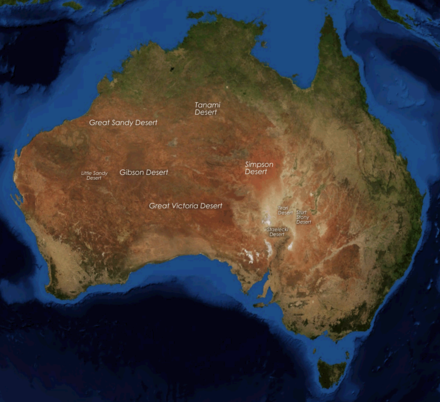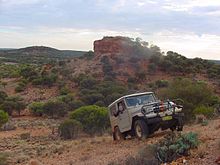- Deserts of Australia
-
Deserts cover a large portion of the land in Australia. Most of the deserts lie in the central and north-western part of the country. The largest part of Australia is desert or semi-arid. The size of the deserts in Australia combined is 1,371,000 square kilometres (529,000 sq mi), and occupy 18% of the continent.[1]
Contents
Australian deserts
Desert State/Territory Size Proportion of
Australian
landmassGreat Victoria Desert Western Australi, South Australia 348,750 km2 134,650 sq mi 4% Great Sandy Desert Western Australia 284,993 km2 110,036 sq mi 3.5% Tanami Desert Western Australia, Northern Territory 184,500 km2 71,200 sq mi 2.4% Simpson Desert Northern Territory, Queensland, South Australia 176,500 km2 68,100 sq mi 2.3% Gibson Desert Western Australia 156,000 km2 60,000 sq mi 2.0% Little Sandy Desert Western Australia 111,500 km2 43,100 sq mi 1.5% Strzelecki Desert South Australia, Queensland, New South Wales 80,250 km2 30,980 sq mi 1.0% Sturt Stony Desert South Australia, Queensland, New South Wales 29,750 km2 11,490 sq mi 0.3% Tirari Desert South Australia 15,250 km2 5,890 sq mi 0.2% Pedirka Desert South Australia 1,250 km2 480 sq mi 0.1% Note that the Western Desert comprises the Gibson Desert, the Great Sandy and Little Sandy Deserts and lies within Western Australia and South Australia. The total area is 524,750 km2 (202,610 sq mi) and is about 9% of the total Australian landmass.
Great Victoria Desert
Main article: Great Victoria DesertThe Great Victoria Desert lies in Western Australia and South Australia. It is over 800 kilometres (500 mi) wide and covers an area of 424,000 square kilometres (164,000 sq mi).
Gibson Desert
Main article: Gibson DesertThe Gibson Desert lies in central Western Australia and is made up of sandhills and dry grass. The desert is about 60,000 square kilometres (23,000 sq mi) in size. Most of the inhabitants of the area are Indigenous Australians.
Simpson Desert
Main article: Simpson DesertThe Simpson Desert lies mainly in the south-east part of the Northern Territory, but parts of it are also in Queensland and South Australia. It covers an area of almost 100,000 square kilometres (39,000 sq mi). The Simpson Desert contains the world's longest parallel sand dunes.
Other Australian deserts
- Little Sandy Desert
- Strzelecki Desert
- Tanami Desert
- Tirari Desert
- Central Desert[dubious ]
- Australian Desert
Desert groups
- Western Desert – grouping of Gibson, Great Sandy and Little Sandy Deserts.
References
External links
- The Australian Landscape, A Cultural History - A four part program exploring the way Europeans and Aboriginal people have engaged with the desert, through art, science and religion, from ABC Radio National
- Encarta (Archived 2009-10-31)
- World Book
- National Geographic
Further reading
- Johnson, John & Catherine de Courcy.(1998) Desert Tracks Port Melbourne, Vic. Lothian Books. ISBN 0850918111
World deserts Africa Asia - Ad-Dahna
- Arabian
- Aral Karakum
- Aralkum
- Badain Jaran
- Betpak-Dala
- Cholistan
- Dasht-e Kavir
- Dasht-e Lut
- Dasht-e Margoh
- Dasht-e Naomid
- Gurbantünggüt
- Gobi
- Hami
- Indus Valley
- Judean
- Karakum
- Kharan
- Kumtag
- Kyzyl Kum
- Lop
- Nefud
- Negev
- Ordos
- Qaidam
- Rub' al Khali
- Russian Arctic
- Registan
- Saryesik-Atyrau
- Syrian
- Taklamakan
- Tengger
- Thal
- Thar
- Tihamah
- Ustyurt Plateau
- Wahiba Sands
- Liwa
Europe North America - Alvord
- Amargosa
- Baja California
- Black Rock
- Carcross
- Channeled scablands
- Chihuahuan
- Escalante
- Forty Mile
- Gran Desierto de Altar
- Great Basin
- Great Salt Lake
- Great Sandy
- Jornada del Muerto
- Kaʻū
- Lechuguilla
- Mojave
- North American Arctic
- Owyhee
- Painted Desert
- Red Desert
- Sevier
- Smoke Creek
- Sonoran
- Tule (Arizona)
- Tule (Nevada)
- Yp
- Yuha
- Yuma
Australia South America Polar regions New Zealand Categories:- Deserts of Australia
- Landforms of Australia
Wikimedia Foundation. 2010.


